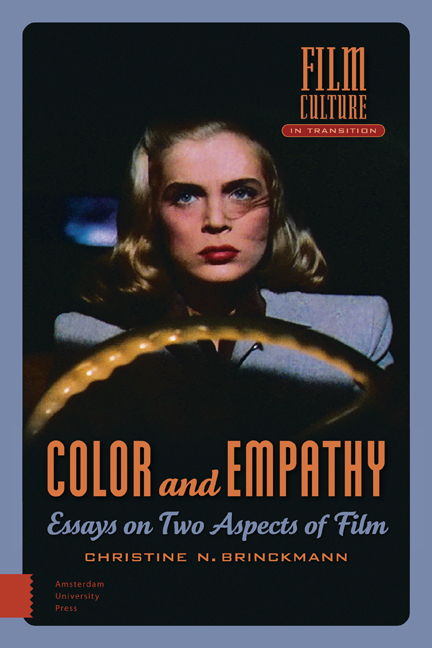Book contents
- Frontmatter
- Contents
- Preface
- Dedication
- Cinematic Color as Likeness and as Artifact: [2001]
- Chords of Color: [2006]
- The Tension of Colors in Colorized Silent Films: [2001]
- Structural Film, Structuring Color: Jenny Okun's Still Life: [1995]
- Desert Fury: A Film Noir in Color: [2012]
- The Work of the Camera: BEAU TRAVAIL: [2005]
- Empathy with the Animal: [1997]
- Motor Mimicry in Hitchcock: [1999]
- Abstraction and Empathy in the Early German Avant-garde: [1997]
- The Role of Empathy in Documentary Film: A Case Study: [2005]
- Genre Conflict in Tracey Emin’s Top Spot: [2007]
- Viewer Empathy and Mosaic Structure in Frederick Wiseman’s PRIMATE: [2009]
- CASTA DIVA: An Empathetic Reading: [2008]
- Publication Data
- Index of Films
- Index of Subjects
- Film Culture in Transition
Cinematic Color as Likeness and as Artifact: [2001]
Published online by Cambridge University Press: 23 June 2021
- Frontmatter
- Contents
- Preface
- Dedication
- Cinematic Color as Likeness and as Artifact: [2001]
- Chords of Color: [2006]
- The Tension of Colors in Colorized Silent Films: [2001]
- Structural Film, Structuring Color: Jenny Okun's Still Life: [1995]
- Desert Fury: A Film Noir in Color: [2012]
- The Work of the Camera: BEAU TRAVAIL: [2005]
- Empathy with the Animal: [1997]
- Motor Mimicry in Hitchcock: [1999]
- Abstraction and Empathy in the Early German Avant-garde: [1997]
- The Role of Empathy in Documentary Film: A Case Study: [2005]
- Genre Conflict in Tracey Emin’s Top Spot: [2007]
- Viewer Empathy and Mosaic Structure in Frederick Wiseman’s PRIMATE: [2009]
- CASTA DIVA: An Empathetic Reading: [2008]
- Publication Data
- Index of Films
- Index of Subjects
- Film Culture in Transition
Summary
It is a common belief that colors can be reproduced in photography and film with utter naturalness, that they can remain legible as in reality itself and reveal the beauty and meaning of nature. But whereas the colors of the world are generally regarded as an embellishment, albeit a superficial one, the color photograph that captures them is often less beautiful. What is the reason for this failure? What are the factors that so often make color photography – and even more so color film – aesthetically unsatisfying? Why is it so much easier to take a good black-and-white photograph? As if nature, which quite obviously comes in color, were resisting the chromatic reproduction of its charms.
With just a modicum of skill or with a little luck, black-and-white images succeed. One need only compare old-fashioned passport photographs with their color counterparts from a photo booth. Although reduced to graphic values, the black-and-white face is of a more essential, more delicate, artful, and yet fascinating similarity, while the color photograph is blotchy, slightly bloated, less flattering, and also less similar. Shouldn't color be truer to life and more expressive, as it conveys more information about the circumstances recorded than a black-and-white image? But paradoxically, the additional information rarely seems an improvement and is more often a tiresome excess. Monochrome photography, as Gerald Mast has noted, selects visual beauty “of necessity, since it ‘sees’ shapes, shadows, forms, and textures that the human eye cannot.” By contrast, the color photograph captures much of the insignificant and ephemeral that we have learned to overlook in reality, and it tends to exaggerate the phenomena. Moreover, the incidental and the essential are mixed in such a way that we are unable to subtract one from the other. Color portraits have to be conceived very carefully in terms of lighting and composition in order to create a successful image we can accept as a likeness.
The group photograph offers a good example of the problem in question. In a black-and-white class photo, all the children are lined up more or less equally, only individualized by their specific features of face and form. At most, a position in the center or on the end of a row creates privileges, and strong contrasts of brightness can seem unfairly eye-catching.
- Type
- Chapter
- Information
- Color and EmpathyEssays on Two Aspects of Film, pp. 11 - 32Publisher: Amsterdam University PressPrint publication year: 2014
- 1
- Cited by



